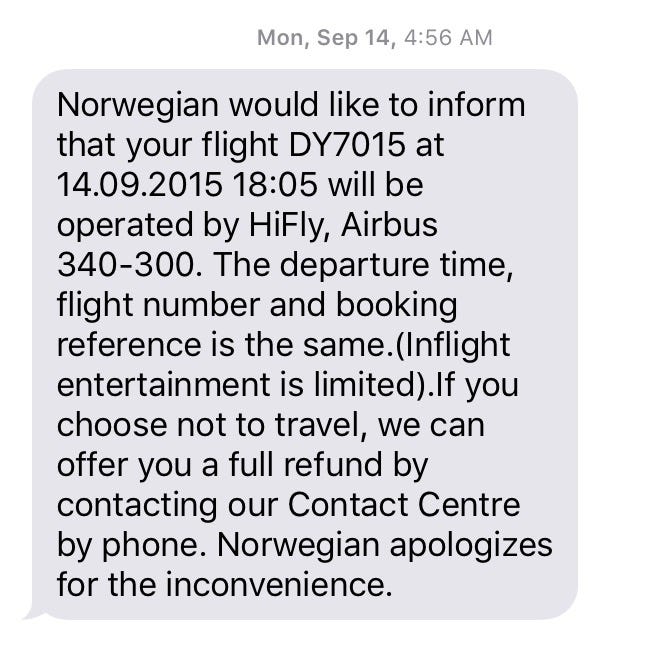Hi Fly: A Lean Airline Story
This past year I took six trips to London. Five of those round trip flights were on Norwegian Air. I HATE Norwegian Air. Without fail, every one of my Norwegian Air flights were delayed at least 2.5 hours. But on one trip back from London, I got a surprising test message.

I had never heard of this HiFly airline before. I was incredibly skeptical but I needed to get home. The plane I boarded was a completely white, unmarked jumbo jet that looked like it came back through time from the early 90s. “Limited” entertainment system is laughable. There was no entertainment system. But I was pleasantly surprised to find they served us food and drinks, unlike Norwegian. Overall it was a decent trip home with a good book and some wine.
I had my second run in with HiFly in September when I was traveling back from England with my mother. I assured her it would be fine, even better because we would get free food and drinks. So she promptly dropped the sandwich from M&S and we boarded the plane.
After we took off I found out we would not be getting food on our eight hour journey back to New York. To say I was enraged is an understatement. Around hour four, I ventured back to ask the crew for some crackers in my best Oliver Twist impression. Luckily, the flight attendant was awesome and fed my mother and me a full meal in the back. While we were chowing down on airplane food, I learned the story of HiFly. And it’s genius.
HiFly is an airline for hire. Because their planes are unmarked, they can fly routes for all major airlines and private companies. When an airline like Norwegian is starting out, they don’t invest in new planes until they can justify the cost. So they operate at full capacity, with every jet being used at all times. If a plane needs to be repaired, they would have to cancel scheduled flights since there are no spares.
That’s where HiFly comes in. Norwegian would call in HiFly, sometimes with only hours notice. The flight team would assemble and fly into wherever they are needed to run the route. This allows Norwegian to keep the scheduled flight and not pay tons of fees in cancellation. It also greatly reduces the risk for starting new airlines.
In addition to saving the butts of new airlines, HiFly is also used to test new flight routes. For example, if United thinks that it should start servicing Buenos Aires to London, they would hire HiFly for three months and sell tickets for the route. At the end of the three months, they analyze the profitability of the route. If it is a good investment, they buy their own jet and establish the route permanently. If it’s not, they stop running the route and move onto something else. This is an airline MVP — the minimum amount of effort to test the value of a new offering.
Many people think lean is about being “cheap”. It’s really about mitigating risk. Even though these airlines have to shell out a hefty amount to hire HiFly, it completely dwarfs the amount of money it would take to create an entirely new route. They would need to buy a plane, hire staff, support it with marketing — and that’s just the beginning. Lean is about lowering your risk of failure by testing your ideas early. When United hires HiFly for a new route, they aren’t investing millions of dollars in this idea before they know people want to fly it.
But, just like with product experiments, there needs to be a certain standard of UX to make the experiment valid. Norwegian screwed up our flight by not providing HiFly with enough food for the flight. This would spell disaster if it happened on a route they were testing. But in our case, Norwegian was just covering their butts so we couldn’t ask for fees, not running a product experiment. On test routes though, the airlines are sure to provide everyone on the plane with a comparable user experience to a regular route.
Even in gigantic, heavily regulated, bureaucratic industries, it is possible to mitigate risk through experiments. HiFly has built a very profitable business by being the MVP of airlines.